Atkinson K. An Introduction to Numerical Analysis
Подождите немного. Документ загружается.

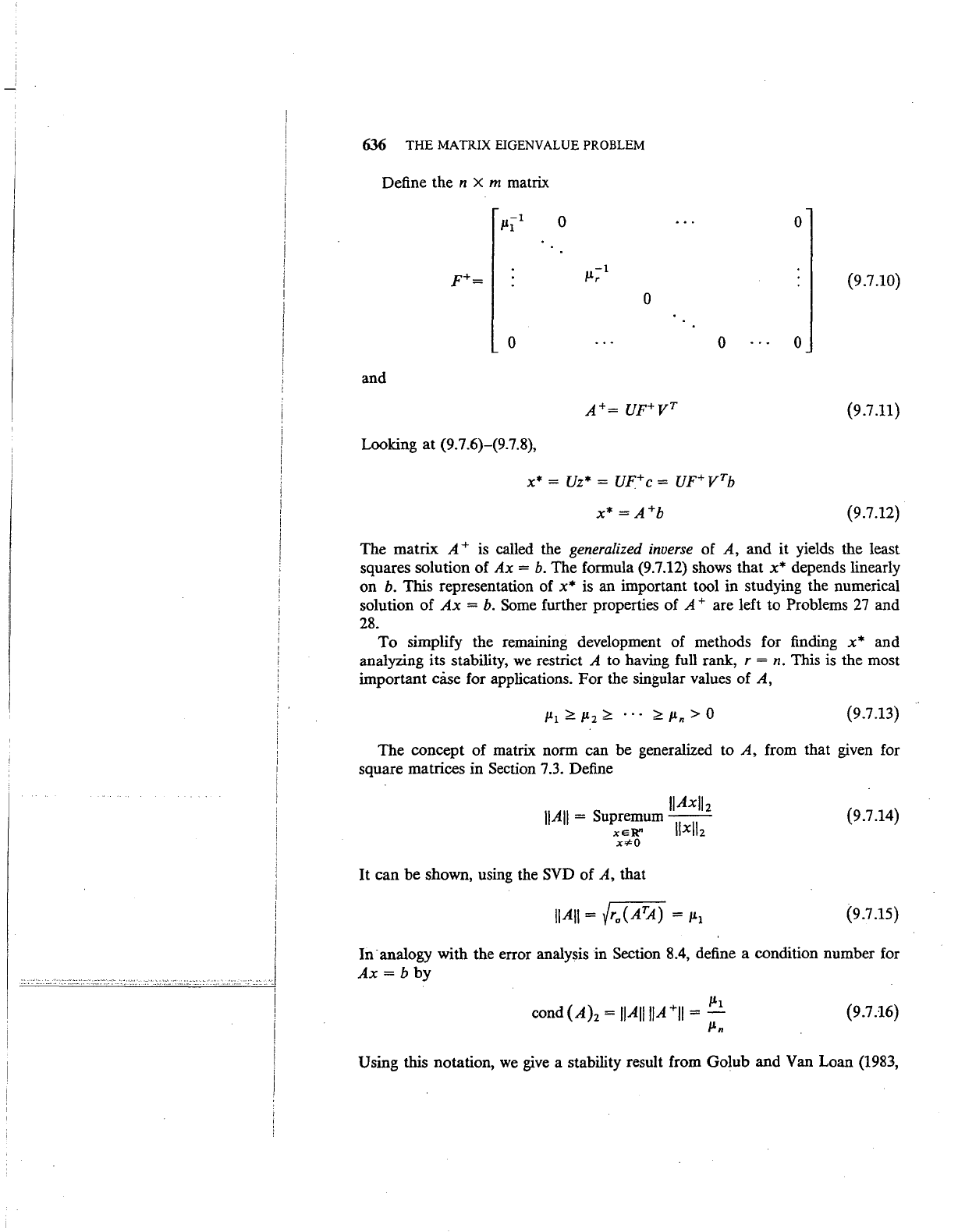
i
i
I
I
J
636
THE
MATRIX EIGENVALUE PROBLEM
Define the n X m matrix
and
-1
p.1
0
Looking
at
(9.7.6)-(9.7.8),
0
-1
P.r
0
0
(9.7.10)
0 0
(9.7.11)
(9.7.12)
The matrix
A+
is
called the generalized inverse of
A,
and it yields the least
squares solution of
Ax=
b.
The formula (9.7.12) shows that x* depends linearly
on
b. This representation of x* is an important tool in studying the numerical
solution of
Ax
=
b.
Some further properties of
A+
are left to Problems 27 and
28.
To
simplify the remaining development of methods for finding
x*
and
analyzing its stability,
we
restrict A to having full rank, r = n. This is the most
important
case for applications.
For
the singular values of
A,
(9.7.13)
The concept of matrix norm can be generalized to
A,
from that given for
square matrices in Section
7.3. Define
11Ax112
IIAII
=
Supremum--
xeR"
llxlb
x¢0
It
can be shown, using the
SVD
of A, that
(9.7.14)
(9.7.15)
In-analogy with the error analysis
in
Section 8.4, define a condition number for
Ax=
b by
P.l
cond(Ah
=
IIAIIIIA+ll
=-
P.n
(9.7.16)
Using this notation,
we
give
a stability result from Golub and Van Loan (1983,

I
I
i
--;
LEAST SQUARES SOLUTION
OF
LINEAR SYSTEMS 637
p. 141).
It
is the analogue of Theorem
8.4,
for the perturbation analysis
of
square
nonsingular linear systems.
Let
b +
ob
and A +
oA
be perturbations
of
b and
A,
respectively. Define
x*
=(A+
oA)+(b +
ob)
r =
b-
Ax*
; = ( b +
ob)
- (A +
oA)
x*
(9.7.17)
Assume
[
IIOAII
lloblb]
1
£=Max
IIAII
'libiG
< cond
(A)2
(9.7.18)
and
.
(O)
=
llrll2
<
1
sm
llhlb
(9.7.19)
implicitly defining
0,
0
.:::.;;
8 < .,
j2.
Then
llx*-
x*lb
[2cond(A)2
[ ( ) ]2] (
2
)
----
< £ + tanO cond A
2
+ 0 £ (9.7.20)
llx*ll2 - cos 0
!If-
rib
llblb
.:::.;;
£[1 +
2cond
(Ah]
Min
{1, m -
n)
+
0(
£
2
) (9.7.21)
For
the case m = n with
rank(A)
= n, the residual r will
be
zero,
and
then
(9.7.20) will reduce to
the
earlier
Theorem
8.4.
The
preceding results say
that
the change
in
r can
be
quite small, while the
change in
x*
can
be quite large.
Note
that the
bound
in
(9.7.20) depends
on
the
square
of
cond
(A
h,
as compared to the dependence
on
cond
(A)
for
the nonsingular case with
m = n [see (8.4.18)].
If
the
columns
of
A are nearly
dependent, then
cond(Ah
can
be
very large, resulting
in
a larger
bound
in
(9.7.20)
than
in
(9.7.21) [see Problem 34(a)]. Whether this is acceptable
or
not
will
depend
on
the problem,
on
whether one wants small values
of
r
or
accurate
values
of
x*.
The
least squares data-fitting problem The origin
of
most
overdetermined linear
systems is
that
of
fitting
data
by
a function from a prescribed family
of
functions.
Let { ( t
i•
b;)
I i = 1,
...
, m} be a given set
of
data, presumably representing some
function
b =
g(t).
Let
cp
1
(t),
...
, cp,(t)
be
given functions,
and
let § be the
family
of
all linear combinations of
cp
1
,
•••
,
cp,:
(9.7.22)
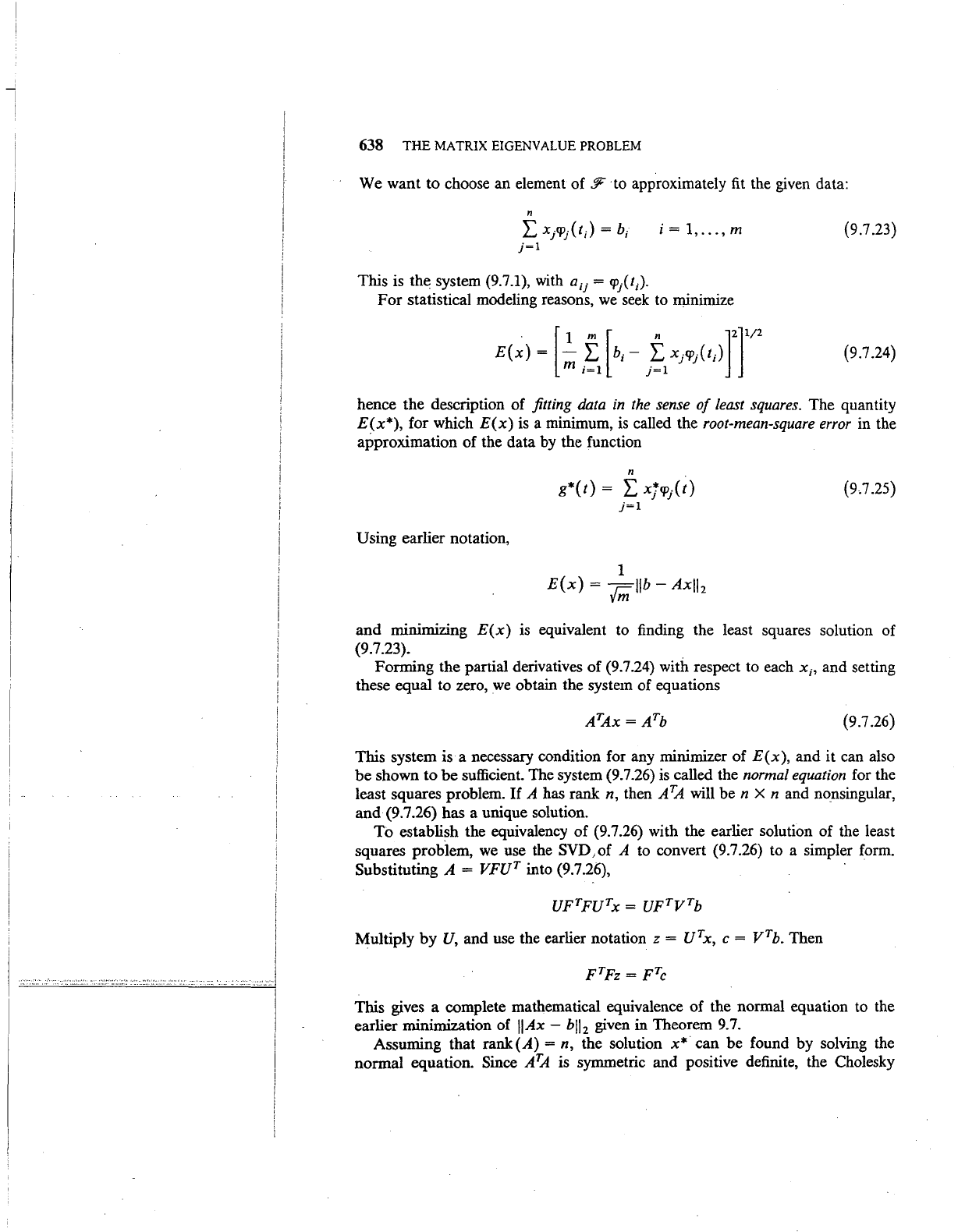
l
!
·-
·•···
..
·-
····-·-.
····-·· --··- ·····-··
..........
·-
..•. -
..
'
I
I
....
I
I
I
'
i
I
i
i
638
THE
MATRIX EIGENVALUE PROBLEM
We want to choose an element of
fF
to approximately
fit
the given data:
n
L XfPj(t;) =
b;
j=l
This is the system (9.7.1),
with
a;j = <p/t;)-
i = 1,
...
, m
For
statistical modeling reasons,
we
seek
to
minimize
· [ } m [ n
]2]1/2
E(x)
= m
.L
b;-
~
xj<pj(t;)
z=l
J=l
(9.7 .23)
(9.7.24)
hence the description of fitting data in the sense
of
least squares. The quantity
E(x*),
for which
E(x)
is a minimum,
is
called the root-mean-square error in the
approximation of the data
by
the function
n
g*(t)
= L xj<pj(t) (9.7.25)
j=l
Using earlier notation,
and minimizing
E(x)
is
equivalent to finding the least squares solution of
(9.7.23).
Forming the partial derivatives of (9.7.24) with respect to each
X;,
and setting
these equal to zero,
we
obtain the system of equations
(9.7.26)
This system is a necessary condition for any minimizer of
E(x),
and it can also
be
shown to
be
sufficient. The system (9.7.26) is called the normal equation for the
least squares problem.
If
A has rank n, then
ATA
will
ben
X n and nonsingular,
and (9.7.26) has a unique solution.
To
establish the equivalency
of
(9.7.26) with the earlier solution of the least
squares problem,
we
use the SVD,of A
to
convert (9.7.26) to a simpler form.
Substituting
A =
VFUT
into (9.7.26),
UFTFUTx =
UFTVTb
Multiply
by
U,
and use the earlier notation z =
urx,
c =
vrb.
Then
This gives a complete mathematical equivalence of the normal equation to the
earlier minimization of
!lAx-
bib
given in Theorem 9.7.
Assuming that rank(A) =
n,
the solution
x*
can be found by solving the
normal equation. Since
A1A
is symmetric and positive definite, the Cholesky
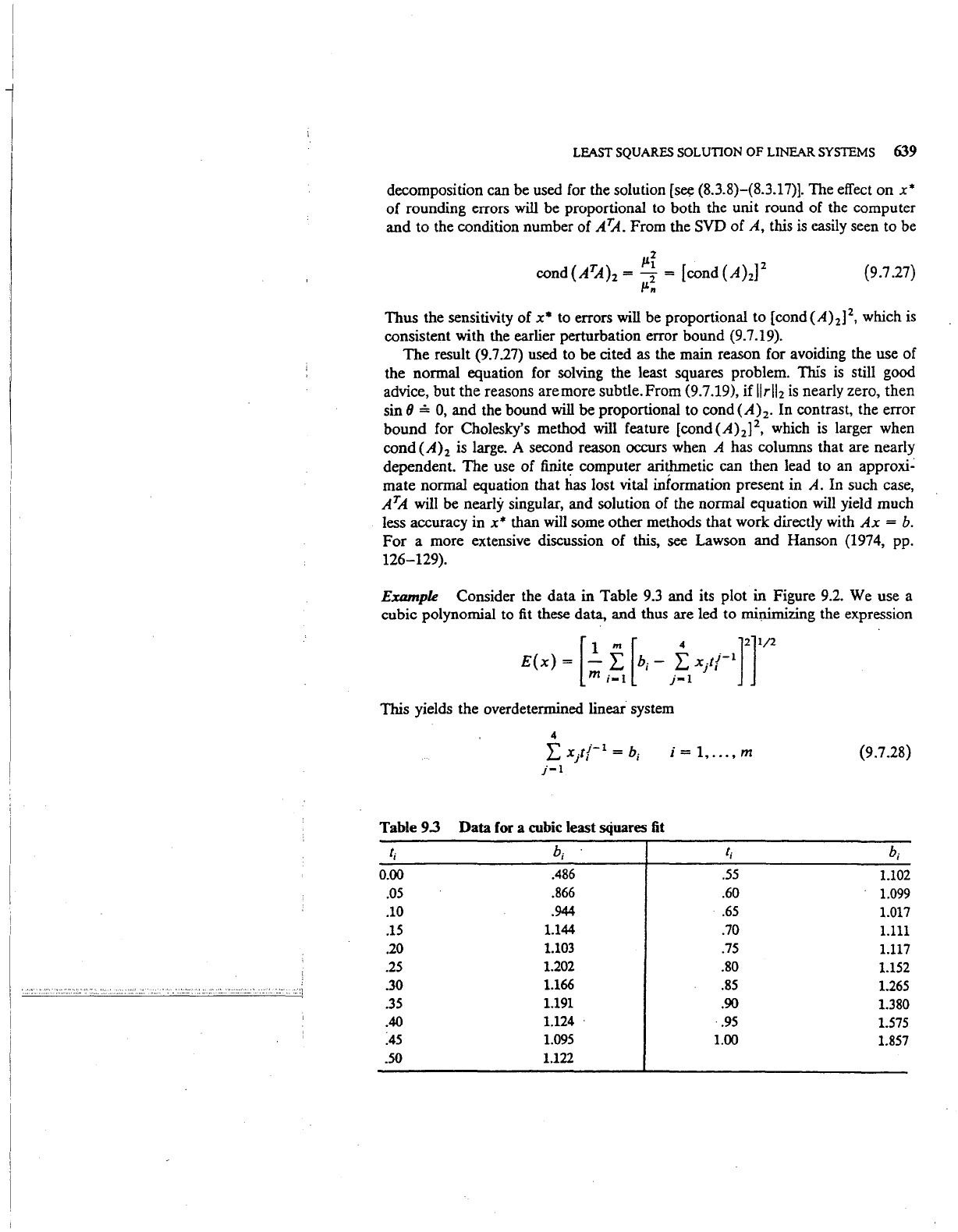
..
''.
,,
......
,
..
·--···-
·--·--·--·-·
"'\
---
..
LEAST
SQUARES
SOLUTION OF LINEAR
SYSTEMS
639
decomposition can be used for the solution
[s~
(8.3.8)-(8.3.17)]. The effect
on
x*
of
rounding errors will be proportional to both the unit round of the computer
and
to
the condition number
of
A1A.
From the SVD
of
A, this
is
easily seen to be
2
cond(A1A)
2
=I'~=
[cond(A)
2
]
2
1'
..
(9.7 .27)
Thus
the sensitivity
of
x* to errors will be proportional to [cond(A)z]
2
,
which is
consistent with the earlier perturbation error bound
(9.7.19).
The
result (9.7.27)
used
to
be
cited as the main reason for avoiding the use of
the normal equation for solving the least squares problem.
This
is
still good
advice,
but
the
reasons
are
more subtle.
From
(9.7.19), if
llrll
2
is
nearly zero,
then
sin 8 = 0,
and
the bound will
be
proportional to cond
(A
)z.
In
contrast, the error
bound
for Cholesky's method will feature [cond (A)z]
2
,
which is larger when
cond
(A)z
is large. A second reason occurs when A has columns that are nearly
dependent.
The
use
of
finite computer arithmetic can then lead to an
approxi~
mate normal equation that has lost vital information present in A. In such case,
ATA
will be nearly singular, and solution of the normal equation will yield much
less accuracy in
x* than will some other methods
that
work directly with
Ax
=
b.
For
a more extensive discussion
of
this, see Lawson
and
Hanson (1974, pp.
126-129).
E:rampk Consider the
data
in Table 9.3
and
its plot in Figure 9.2. We use a
cubic polynomial to
fit
these data, and thus are led to
mi~ng
the expression
This yields the overdetermined linear system
Table 9.3
t;
0.00
.05
.10
.15
.20
.25
.30
.35
.40
:45
.50
4
~
x.ri-
1
=b.
i..J ) I I
j-1
Data
for a cubic least squares
fit
b;
.486
.866
.944
1.144
1.103
1.202
1.166
1.191
1.124
1.095
1.122
i = 1,
...
, m
t;
.55
.60
..
65
.70
.75
.80
.85
.90
.95
1.00
(9.7.28)
1.102
1.099
1.017
1.111
1.117
1.152
1.265
1.380
1.575
1.857
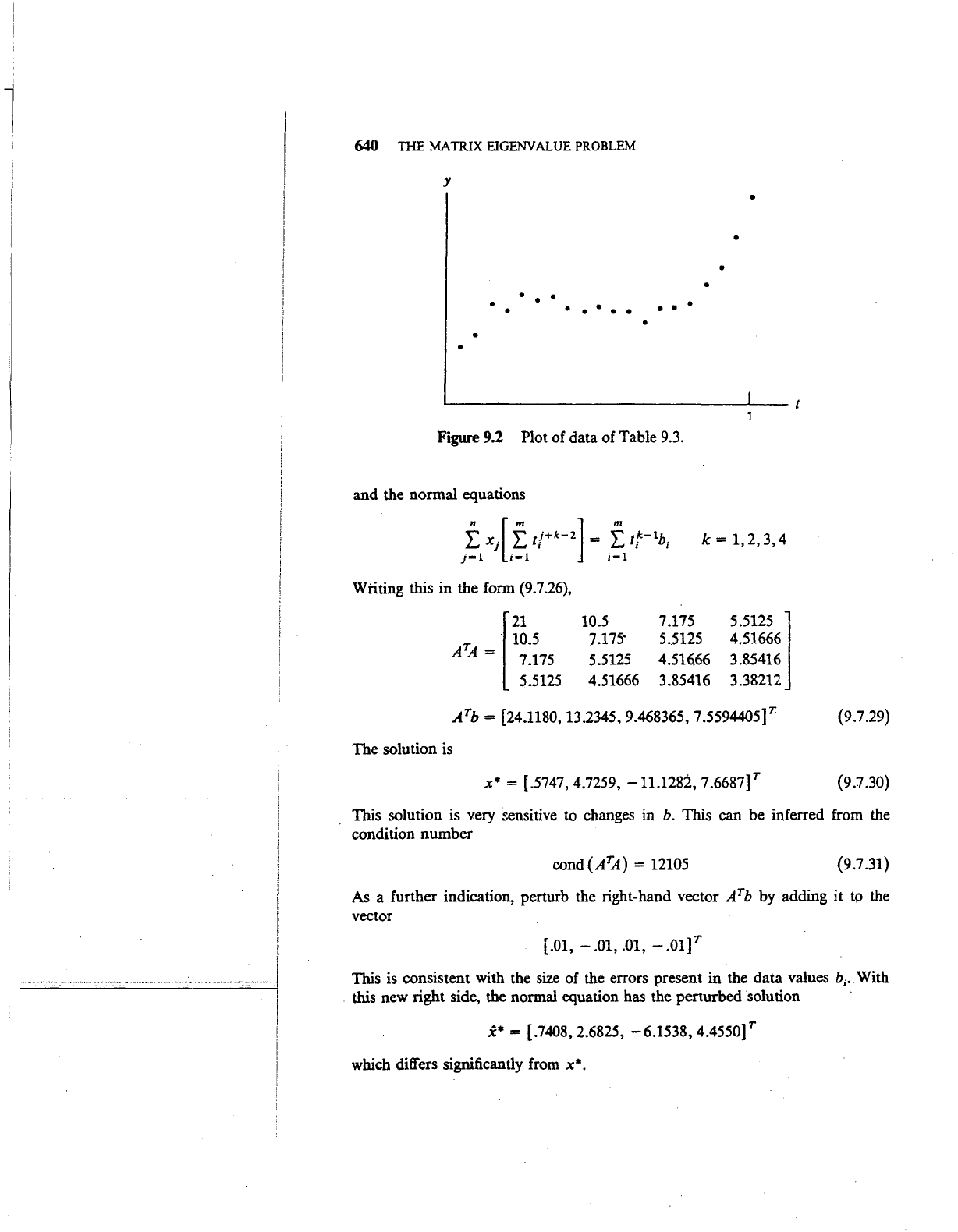
640
THE
MATRIX EIGENVALUE PROBLEM
y
•
•
•
•
• •
•
• •
••••
•
••
•
•
•
•
Figure
9.2
Plot of data of Table
9.3.
and the normal equations
Writing this in the form (9.7.26),
[
21
T . 10.5
A
A=
7.175
5.5125
10.5
7.175"
5.5125
4.51666
k=1,2,3,4
7.175
5.5125
4.51666
3.85416
5.5125]
4.51666
3.85416
3.38212
A
7
b = [24.1180, 13.2345, 9.468365,
7.5594405f
The solution
is
x* = [.5747, 4.7259,
-11.1282,
7.6687f
(9.7.29)
(9.7.30)
This solution is very sensitive
to
changes in
b.
This can be inferred from the
condition number
cond
(A
7
A) =
12105
(9.7.31)
As
a further indication, perturb the right-hand vector
Arb
by adding it
to
the
vector
[.01, - .01,
.01,-
.01f
This
is
consistent with the
size
of the errors present in the data values
b;.
With
this new right side, the normal equation has the perturbed solution
x•
= [.7408, 2.6825,
-6.1538,
4.455of
which differs significantly from x*.
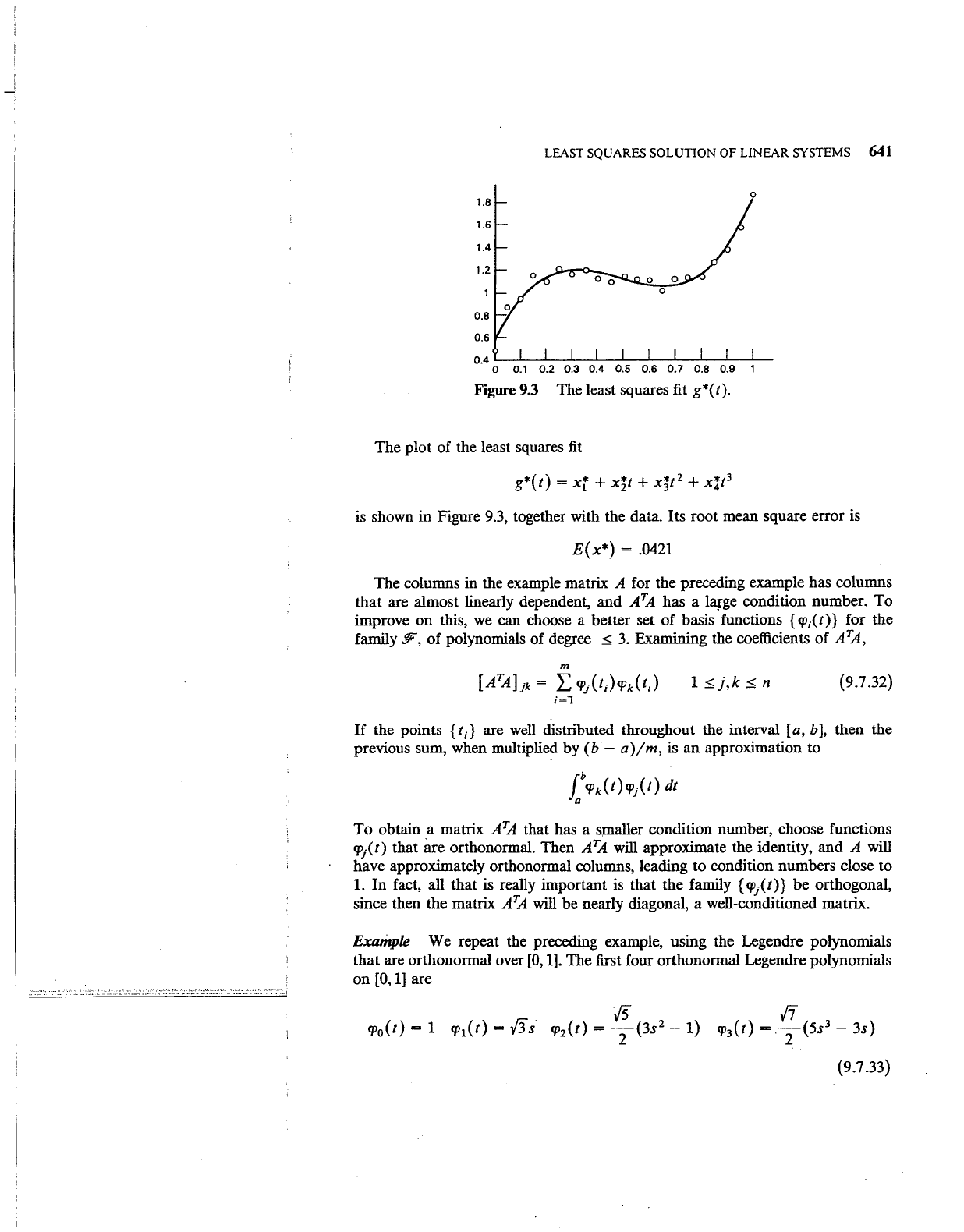
LEAST SQUARES SOLUTION OF LINEAR SYSTEMS
641
0.4
L...-....L----L-.l.---L---1-...J.---L-.I...-....L---L-
0 0.1 0.2 0.3
0.4
0.5 0.6
0.7
0.8 0.9 1
Figure 9.3 The least squares fit g*( t
).
The plot of the least squares
fit
is shown in Figure 9.3, together with the data. Its root mean square error is
E(x*) = .0421
The columns in the example matrix A for the preceding example has columns
that are almost linearly dependent, and
ATA
has a large condition number.
To
improve
on
this,
we
can choose a better set
of
basis functions { IP;(t)} for the
family
ffi",
of
polynomials of degree
~
3.
Examining the coefficients of ATA,
m
[ATA]jk
= L cpj(t;)cpk(t;)
1
~j,k
~
n (9.7.32)
i="l
If
the points {t;} are well distributed throughout the interval
[a,
b
],
then the
previous sum, when multiplied by
(b-
a)jm,
is
an
approximation to
To
obtain a matrix
AlA
that has a smaller condition number, choose functions
cp/t)
that are orthonormal. Then
AlA
will approximate the identity,
and
A will
have approximately orthonormal columns, leading to condition numbers close to
1.
In
fact, all thai is really important is that the family { IP/ t)} be orthogonal,
since then the matrix
ATA
will be nearly diagonal, a well-conditioned matrix.
Example We repeat the preceding example, using the Legendre polynomials
that are orthonormal over
[0,
1].
The first four orthonormal Legendre polynomials
on
[0,
1]
are
15
ff
cp
0
(t)
= 1
cp
1
(t)
=
ffs
cp
2
(t)
=
2(3s
2
-1)
cp
3
(t)
=
2(5s
3
-
3s)
(9.7.33)
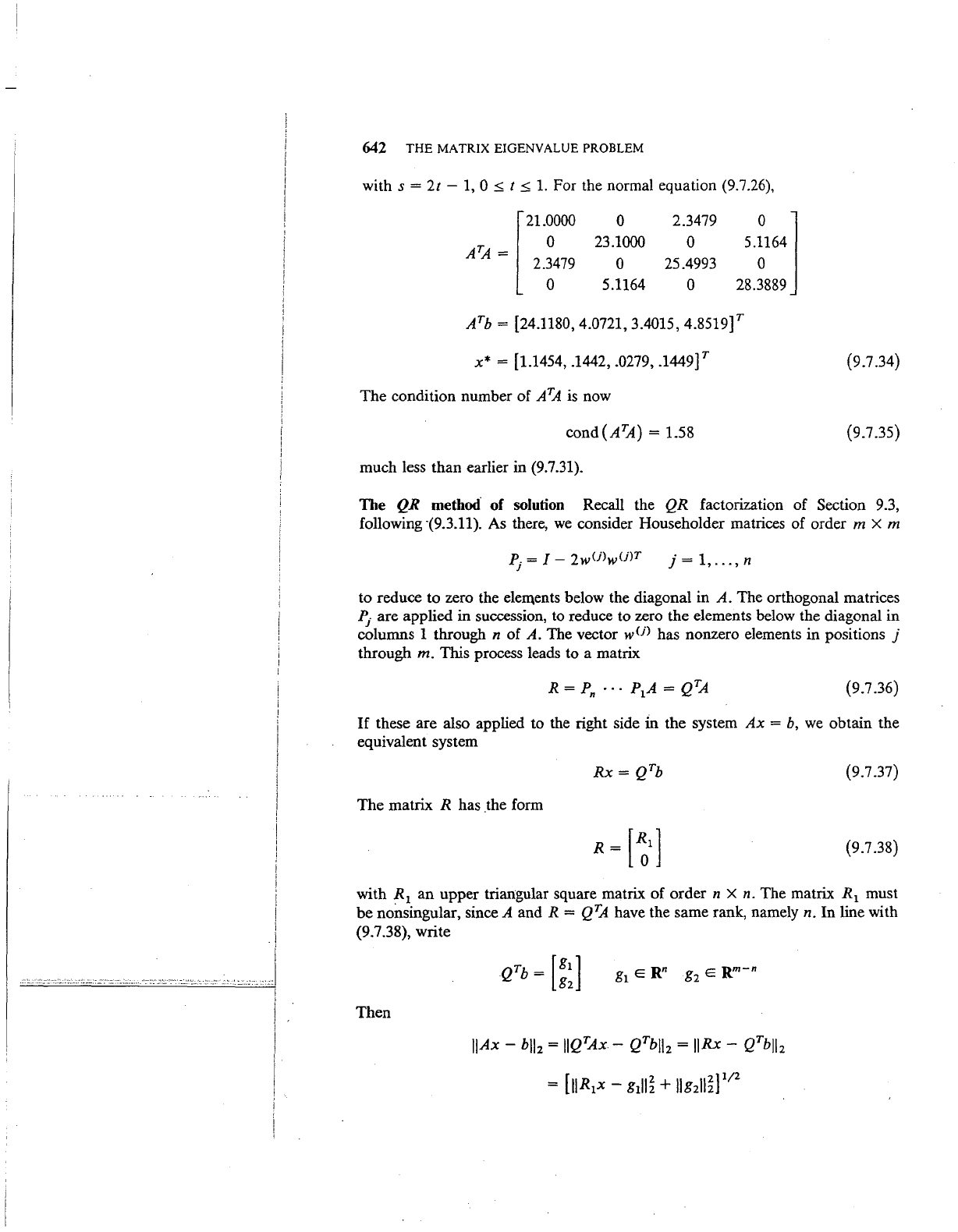
'·'·
·'"··"··•"''--·····'··.
""--·-·---··-··-··-···--
..
I
!
I
.I
642
THE
MATRIX EIGENVALUE PROBLEM
with s =
2t
-
1,
0
~
t
~
1.
For the normal equation (9.7.26),
T - 0
5.1164
[
21.0000
A
A-
2.~479
0
23.1000
0
5.1164
2.3479
0
25.4993
0
0 l
28.~889
ATb = [24.1180, 4.0721, 3.4015,
4.8519f
x* = [1.1454, .1442, .0279,
.1449f
The
condition number of
ATA
is now
cond(ATA)
= 1.58
much less than earlier in (9.7.31).
(9.7.34)
(9.7.35)
The QR
method.
of
solution Recall the
QR
factorization of Section 9.3,
following
·(9.3.11). As there,
we
consider Householder matrices of order m X m
Pj
=I-
2wUlwUlT
j = 1,
...
, n
to reduce to zero the elell\ents below the diagonal in
A.
The orthogonal matrices
Pj
are
applied in succession, to reduce to zero the elements below the diagonal
in
columns 1 through n
of
A.
The vector
wUl
has nonzero elements in positions j
through m. This process leads to a matrix
R = P
···
PA
=
QTA
n 1
(9.7 .36)
If
these are also applied to the right side
in
the system
Ax
=
b,
we
obtain the
equivalent system
(9.7.37)
The
matrix R has .the form
(9.7.38)
with
R
1
an
upper triangular square matrix of order n X n. The matrix R
1
must
be
nonsingular, since A and R = Q
1A
have the same rank, namely n. In line with
(9.7.38), write
Then
IIAx -
bib
=
IIQTAx-
QTblb =
IIRx
- QTblb
= [IIRlx-
g11l~
+
llg211~]
112
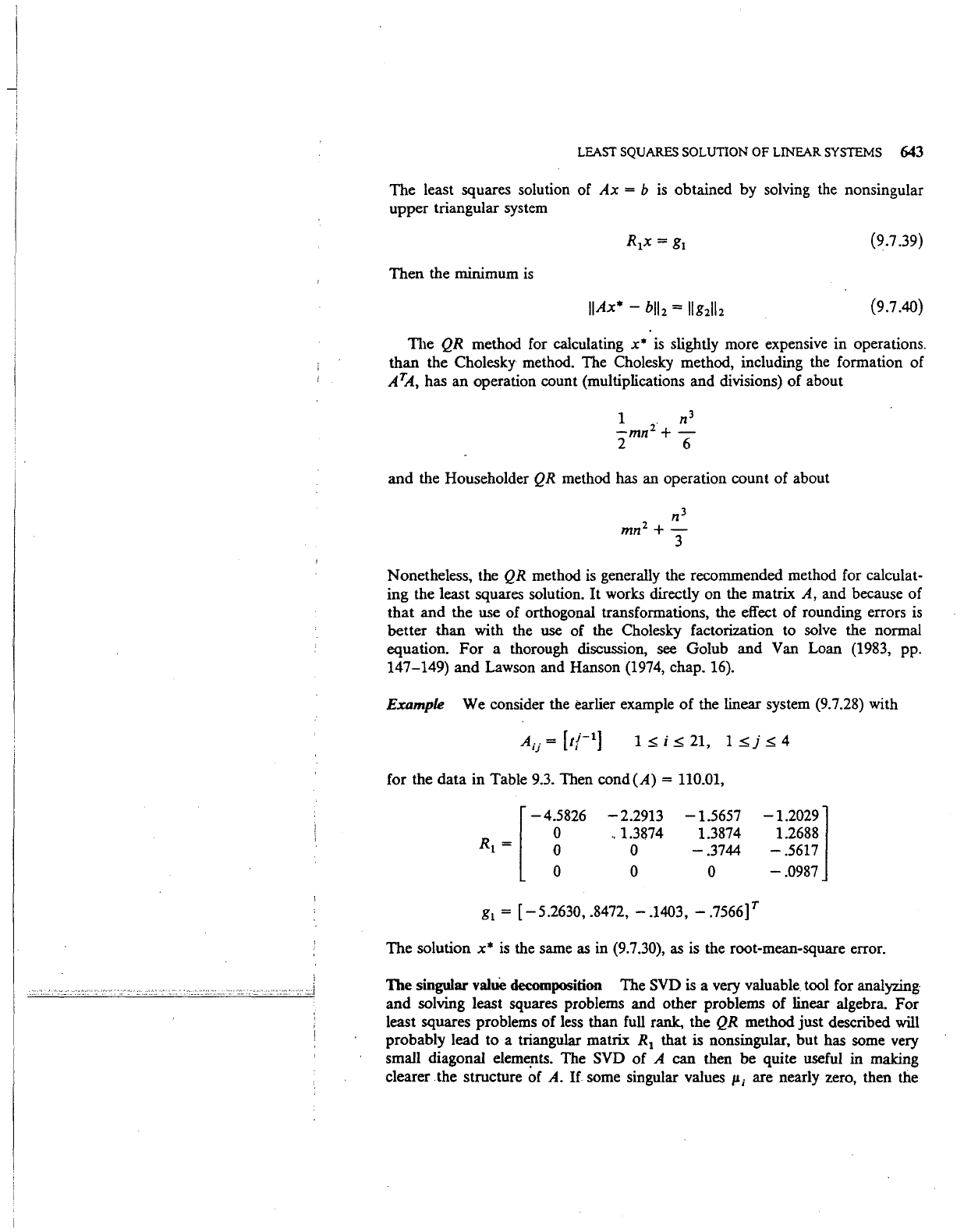
j
--
···-·
··--··
-·
.
.J
LEAST SQUARES SOLUTION
OF
LINEAR SYSTEMS
643
The least squares solution of
Ax
= b
is
obtained by solving the nonsingular
upper triangular system
(9.7 .39)
Then the minimum
is
(9.7.40)
l11e
QR
method for calculating
x•
is slightly more expensive in operations.
than
the Cholesky method. The Cholesky method, including the formation of
ATA, has an operation count (multiplications and divisions) of about
1 . n
3
-mn
1
+-
2 6
and
the Householder QR method has an operation count of about
n3
mn
1
+-
3
Nonetheless, the
QR
method is generally the recommended method for calculat-
ing the least squares solution.
It
works directly on the matrix A, and because of
that
and
the use of orthogonal transformations, the effect
of
rounding errors
is
better
than
with the use of the Cholesky factorization to solve the normal
equation.
For
a thorough discussion, see Golub
and
Van Loan (1983, pp.
147-149)
and
Lawson and Hanson (1974, chap. 16).
EXDmple We consider the earlier example
of
the linear system (9.7.28) with
A .. = [t!-
1
)
IJ
I
1
~
i
~
21, 1 :::;,j
~
4
for the
data
in Table 9.3. Then
cond(A)
= 110.01,
-2.2913
..
1.3874
0
0
-1.5657
1.3874
-.3744
0
gl
=
[-5.2630,.8472,
-.1403,
-.7566f
-1.2029]
1.2688
-.5617
-.0987
The
solution
x•
is
the same as in (9.7.30), as is the root-mean-square error.
The
singular
value
decomposition The SVD is a very valuable. tool for analyzing·
and
solving least squares problems and other problems
of
linear algebra.
For
least squares problems
of
less than full rank, the QR method just described will
probably lead to a triangular matrix R
1
that is nonsingular, but has some very
small diagonal
elem~ts.
The SVD
of
A can then be quite useful in making
clearer the structure of
A.
If
some singular values ll; are nearly zero, then the
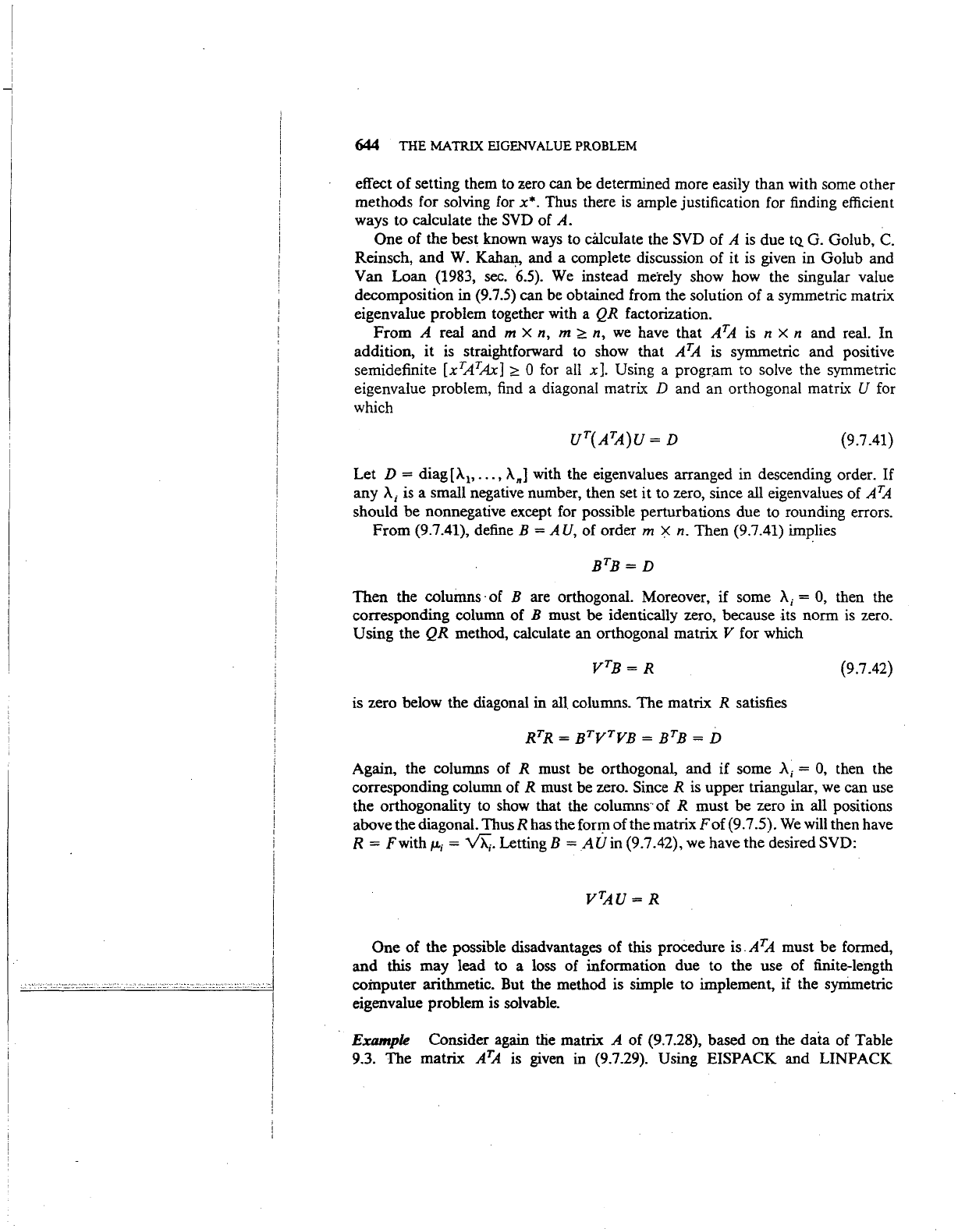
644
THE
MATRIX EIGENVALUE PROBLEM
effect
of
setting them to zero can
be
determined more easily than with some other
methods for solving for
x*.
Thus there
is
ample justification for finding efficient
ways
to
calculate the SVD
of
A.
One
of
the best known ways to calculate the SVD
of
A is due
tQ
G. Golub, C.
Reinsch,
and
W.
Kah~,
and a complete discussion
of
it is given in Golub
and
Van Loan (1983,
sec.
6.5).
We
instead merely show how the singular value
decomposition
in
(9.7.5) can be obtained from the solution
of
a symmetric matrix
eigenvalue problem together with a QR factorization.
From
A real and m X n, m
~
n,
we
have that
ATA
is n X n and real. In
addition,
it
is straightforward to show that
A1A
is symmetric
and
positive
semidefinite
[xTATA.x]
~
0 for all x]. Using a progr.am to solve
the
symmetric
eigenvalue problem, find a diagonal matrix D and
an
orthogonal matrix U for
which
(9.7.41)
Let D = diag[A
1
,
••.
,
An]
with the eigenvalues arranged in descending order.
If
any
A;
is a small negative number, then set
it
to zero, since all eigenvalues of
ATA
should
be
nonnegative except for possible perturbations due to rounding errors.
From
(9.7.41), define B
=AU,
of
order m
~
n. Then (9.7.41)
imJ>lies
BTB=D
Then
the columns-of B are orthogonal. Moreover,
if
some
A;=
0, then the
corresponding column
of
B must be identically zero, because its norm
is
zero.
Using the
QR
method, calculate an orthogonal matrix V for which
(9.7.42)
is zero below the diagonal in all columns.
The
matrix R satisfies
RTR =
BTV
7
VB = B
7
B = D
Again, the columns of R must be orthogonal,
and
if some
A;
=
0,
then the
corresponding column
of
R must be zero. Since R is upper triangular, we can use
the orthogonality to show that the columns"
of
R must
be
zero
in
all positions
above
the
diagonal. Thus R has the
for~
of
the
matrix F
of
(9. 7 .5).
We
will then have
R =
Fwith
JL;
=~-Letting
B
=AU
in (9.7.42), we have
the
desired SVD:
One
of
the possible disadvantages
of
this procedure is.ATA must
be
formed,
and
this
may
lead to a loss
of
information due to
the
use
of
finite-length
computer arithmetic. But the method is simple to implement, if the synimetric
eigenvalue problem is solvable.
Example Consider again tlie matrix A
of
(9.7.28), based
on
the
data
of
Table
9.3. The matrix
ATA
is given in (9.7.29). Using EISPACK and
UNPACK
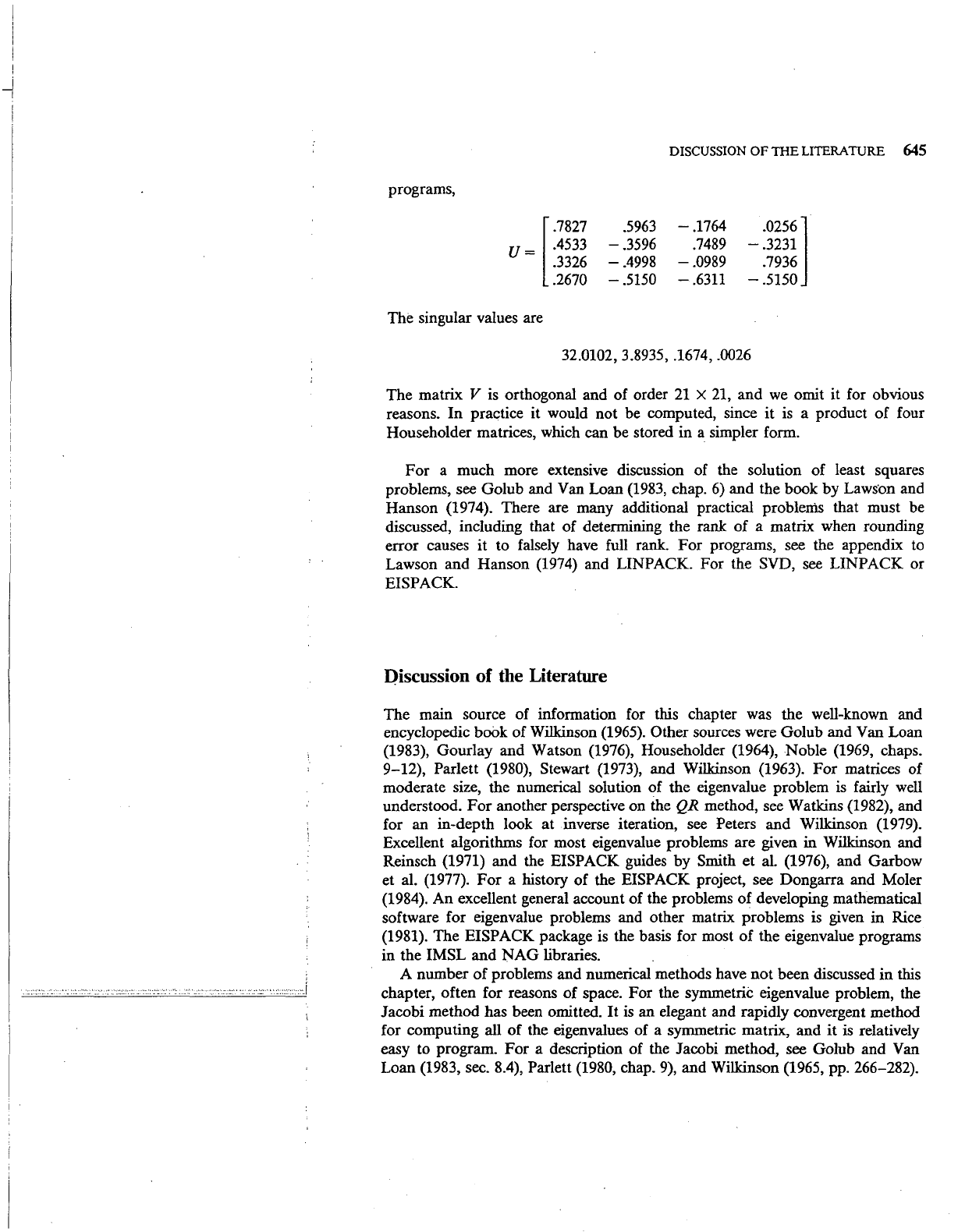
j
I
'·"'"""'
'••
..........
'
··-···-
....
.
...
j
programs,
[
.7827
u = .4533
.3326
.2670
The singular values are
.5963
-.3596
-.4998
-.5150
DISCUSSION
OF
THE
LITERATURE
645
-.1764
.7489
-.0989
-.6311
.0256]
-.3231
.7936
-.5150
32.0102, 3.8935, .1674, .0026
The matrix V is orthogonal and of order
21
X 21, and
we
omit it for obvious
reasons.
In
practice it would not be computed, since it
is
a product of four
Householder matrices, which can be stored in a simpler form.
For
a much more extensive discussion of the solution of least squares
problems, see Golub and Van Loan
(1983, chap. 6) and the book by Lawsbn and
Hanson
(1974). There are many additional practical problems that must be
discussed, including that of determining the rank of a matrix when rounding
error causes it to falsely have full rank. For programs, see the appendix to
Lawson and Hanson
(1974) and UNPACK. For the SVD,
see
LINPACK or
EISPACK.
l)iscussion
of
the Literature
The main source of information for this chapter was the well-known and
encyclopedic
book of Wilkinson (1965). Other sources were Golub and Van Loan
(1983), Gourlay and Watson (1976), Householder (1964), Noble (1969, chaps.
9-12), Parlett (1980), Stewart (1973), and Wilkinson (1963).
For
matrices of
moderate size, the numerical solution of the eigenvalue problem
is
fairly
well
understood.
For
another perspective on the
QR
method, see Watkins (1982), and
for an in-depth look
at
inverse iteration, see Peters and Wilkinson (1979).
Excellent algorithms for most eigenvalue problems are given
in
Wilkinson and
Reinsch
(1971) and the EISPACK guides by Smith et al. (1976), and Garbow
et al.
(1977).
For
a history of the EISPACK project, see Dongarra and Moler
(1984). An excellent general account of the problems of developing mathematical
software for eigenvalue problems and other matrix problems is given in Rice
(1981). The EISPACK package is the basis for most of the eigenvalue programs
in the
IMSL and NAG libraries.
A number
of
problems and numerical methods have not been discussed in this
chapter, often for reasons of space. For the symmetric eigenvalue problem, the
Jacobi method has been omitted.
It
is
an elegant and rapidly convergent method
for computing
all of the eigenvalues of a symmetric matrix, and
it
is relatively
easy to program.
For
a description of the Jacobi method, see Golub and Van
Loan
(1983, sec. 8.4), Parlett (1980, chap. 9), and Wilkinson (1965, pp. 266-282).
